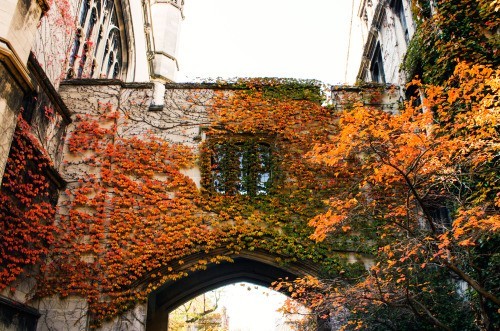Our Autumn 2016 calendar is live. Full details after the jump!
October 3, 4:30-6: Cam Ferguson, “The Beloved Son Crucified: The Aqedah in Mark and Paul” (Swift 201: Co-sponsored with Early Christian Studies Workshop)
- This paper seeks to demonstrate that both the Apostle Paul and the Gospel of Mark use and subvert the narrative of the binding of Isaac (Gen 22) in profoundly similar ways and for profoundly similar purposes. Indeed, it suggests that the latter re-composes and destabilizes the Aqedah precisely to bolster the exegetical claims of the former. This paper begins by tracing two separate, though not mutually exclusive, interpretive trajectories in Isaac’s binding in Second Temple thought. It then looks closely at the use of the Aqedah in Paul and Mark respectively. It will conclude with an argument that both Mark and Paul subvert the Aqedah in order to undermine the promises there ratified in a genetic, circumcised son so as to make room for an inclusion of the nations in early Christ believing communities.
October 20, 6-8: Dinner with Prof. James Osborne (Prof. Stackert’s home)
- Join us for dinner and casual conversation with James Osborne, Assistant Professor of Anatolian Archaeology at the University of Chicago’s Oriental Institute. Prof. Osborne was recently on the academic job market and has graciously agreed to share his is infinite wisdom with us about his experience. It should also be a wonderful opportunity to welcome Prof. Osborne into our Biblical Studies community while eating some good food. Please RSVP to MCunningham1@uchicago.edu for this event so we have an idea about numbers for dinner preparation.
November 2, 4:30-6: Jessie DeGrado and Matt Richey, “The Ashmolean Museum Inscribed Pazuzu Statuette” (Swift 106)
- In 1892, G. J. Chester presented the Ashmolean Museum (Oxford) with a statuette allegedly from San el-Hagar, Egypt. The statuette was first published seventy years later by P. R. S. Moorey (1965 [Iraq 27]), who identified the figure as the infamous Mesopotamian demon Pazuzu. In addition to his striking iconographic attributes, the winged demon bears on his legs a four-line Phoenician or Aramaic inscription from Iron I or IIA. Since the original and only prior publication of this inscription (G. R. Driver 1965 [Iraq 27]) was acknowledged by its author to be very preliminary — owing mainly to corrosion on the statue’s surface — we are presently producing a new study, on the basis of personal inspection of the statue and new imaging techniques that allow greater confidence in decipherment. In our talk, we will present the preliminary results of this study and offer some general comments on what this statue and its inscription reveal about the penetration of Mesopotamian demonology into the West.
November 7, 4:30-6: Sarah Yardney, “1 Sam 14:41 As an Example of Interpretation in LXX Samuel” (Swift 106)
- The Septuagint translator of Samuel is widely considered a “literal” translator who does not engage in interpretation. The example of 1 Sam 14:41, however, demands that we nuance our description of the translator to allow for the possibility that he could intentionally depart from his Vorlage when he considered it in need of correction or improvement. Careful attention to the meaning of the Greek witnesses for this verse reveals that the translator chose to render the Hebrew consonants tmym as tāmîm rather than the intended tummîm in order to address a perceived irregularity in the narrative. Evidence from a wide range of early Jewish sources supports this conclusion.
December 5, 4:30-6: Prof. Jeffery Stackert, “The Elohistic Horeb Narrative in Jewish and Christian Interpretation: Two Examples” (Swift 106: Co-sponsored with Early Christian Studies Workshop)
- The Elohistic Horeb narrative has played a pivotal role in both Judaism and Christianity. In particular, its portrayal of divine revelation as well as its specific legal content have been key components in the development of both Jewish and Christian thought and practice from antiquity to modernity. Yet some of the influences of this Elohistic text do not reflect the plain sense of the text closely and thus have not been perceived as clearly. In this paper, I will focus on two such examples, one Christian and one Jewish. The first concerns the tradition of the Eucharist in Mark 14:23–24 and 1 Cor 11:23–26 and its allusion to Exod 24:8. I will argue that this allusion actually extends back to Exod 24:5–6 and forward to v. 11bβ. In so doing, it attempts to justify the consumption of blood in the Eucharist. The second example comes from the medieval illuminated haggadah known as “The Bird’s Head Haggadah.” In this text, the majority of the characters depicted appear with avian heads. I will argue that this portrayal represents a creative interpretation of Exod 19:4–6 in which the deity is understood to have turned the Israelites themselves into birds. In each of these instances, the interpretation of the Elohistic Horeb narrative departs markedly from its plain sense and is, as such, a striking example of the elasticity of the biblical text in the hands of its interpreters. At the same time, these interpretations show some tendencies toward the critical methods of interpretation employed by modern scholars.
December 5, 6:30-8: Drinks and Snacks at the Pub! (Sponsored by the Bible Party)
- Following Prof. Stackert’s paper, we will be celebrating the success (and close!) of the Fall quarter with appetizers and drinks at the Pub (in the basement of Ida Noyes Hall). Join us to ask Prof. Stackert the burning questions you were afraid during the workshop (or to talk about the Patriots and their 6th string quarterback). It will be a great last hurrah before the final paper push.
All meetings will feature light snacks and refreshments. If you have any questions or concerns, or are interested in presenting a paper in future workshops, please feel free to email the workshop’s co-coordinators: Sun Bok Bae (sunbok@uchicago.edu) or Marshall Cunningham (MCunningham1@uchicago.edu)

